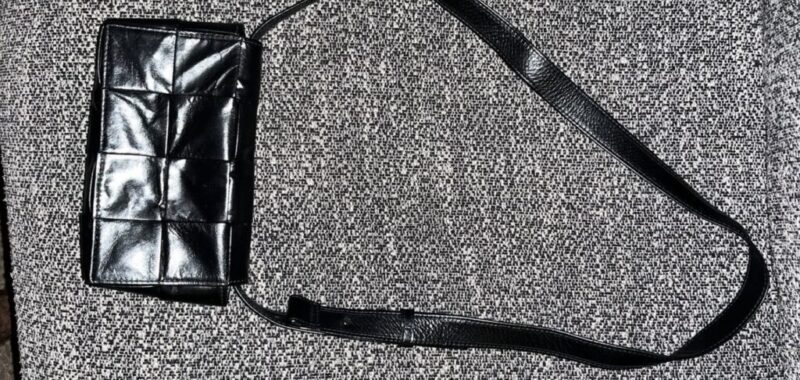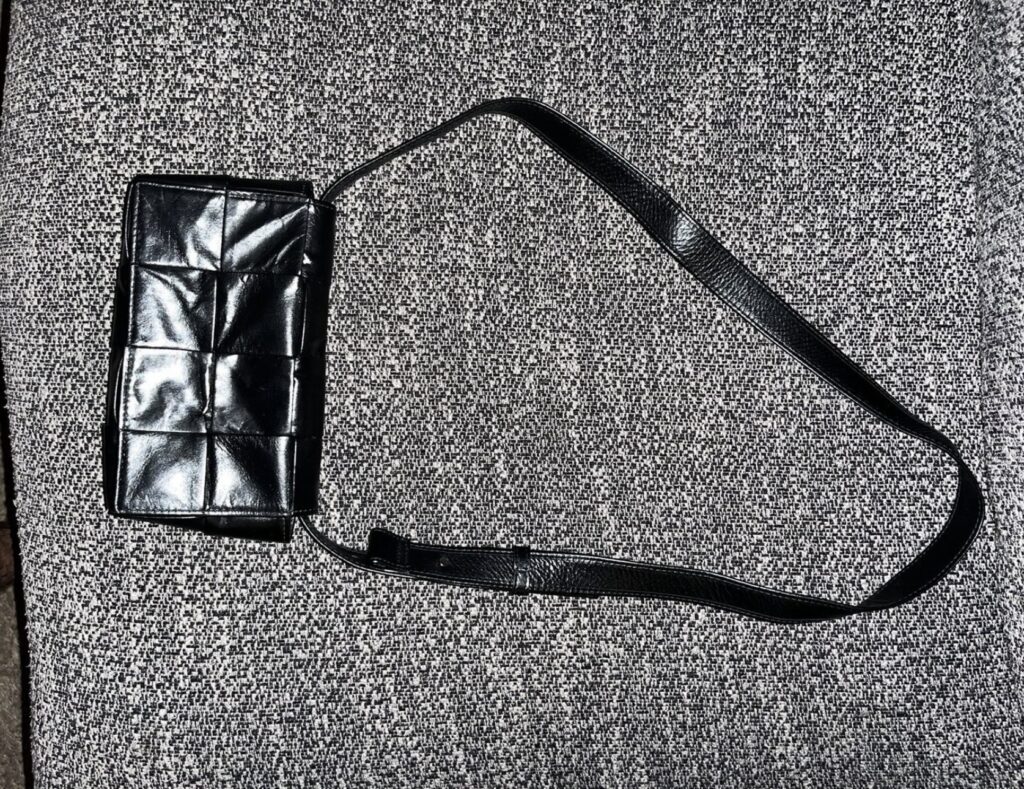
Photographs courtesy of the author.
The big one was too big. And the little one? The little one was too little.
I was looking for something in a place where it was impossible to find what I was looking for. I was in an Acne Studios store in Tokyo looking for a “work bag,” and I was delusional. A handbag that costs more than $1,500, made from the skin of an Italian baby cow, does not need to account for the dimensions of a thirteen-inch MacBook. It does not need to work for a living, commute via subway, or fly Spirit Airlines. It is a thing of fantasy. If I were truly searching for utility, I would use a tote bag.
The “work bag” was an excuse. What I really wanted was not a work bag or even a handbag but a portal to a glamour so total it could engulf me. I know from both advertisements and experience that there are many such portals. But entry requires preparation and research.
A lot of people are obsessed with bags. They talk, vlog, and post about them on the internet. But in real life, it is uncouth to talk about designer bags. It is couth only to have one appear on your arm and, when someone asks about how much it cost, to be nonchalant. I have trouble being nonchalant. I am usually flustered. I deflect, I stress how much of a discount I got. I worry people will think I am shallow, or that I have more money than I do. I just love design, I say, and even I am not convinced.
This is how I found myself in an Acne Studios store, looking for a portal.
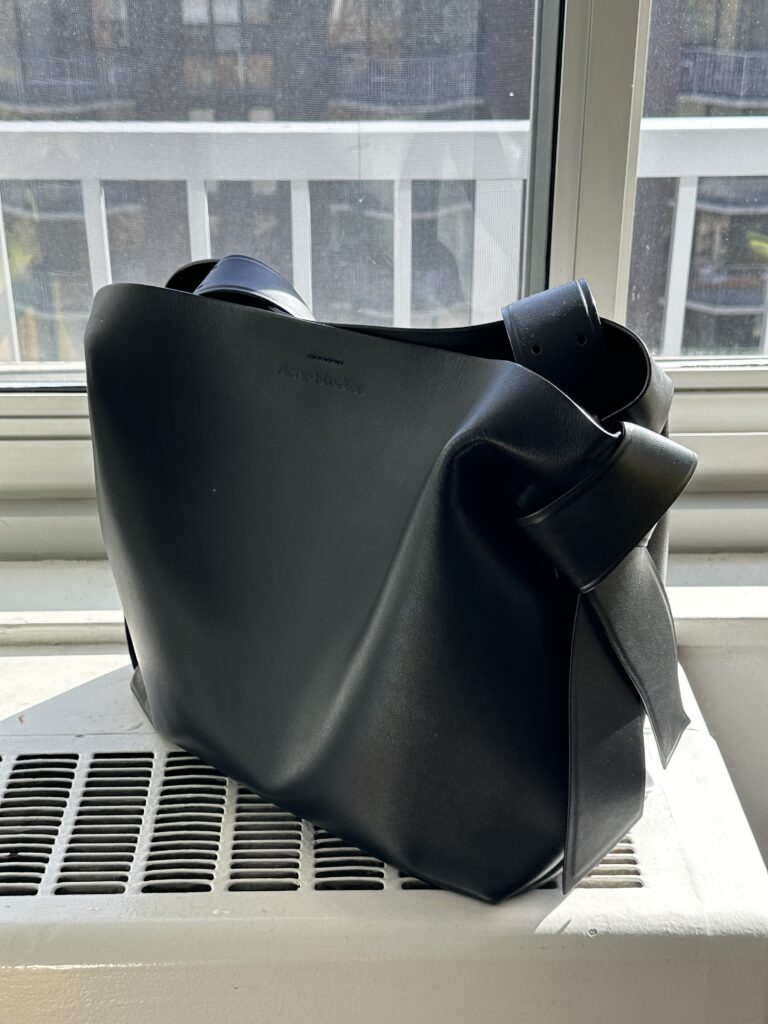
1. Acne Studios Musubi Midi Shoulder Bag
The portal is shaped like a square. It is made of a firm, matte leather that gives it structure but lets it remain pleasingly slouchy, as if aware that it should not try too hard. A wide strap allows it to be carried over the shoulder, or, on a small enough person, draped across the body. I’ve decided on the one that is too big, the Midi, sacrificing cuteness for utility. The strap and the bag intersect miraculously in a Japanese obi knot, the kind used to tie a sash around a kimono. When I touch it, I sense every Acne photo shoot, celebrity endorsement, and runway show lacquered onto its leather, invisible to the eye but humming below the surface.
As the sales associate walks me through the bag’s features, I pretend that it is my first time hearing about them. I pretend I have not already spent hours with the bag on YouTube, that I have not gone to see it twice in person in New York, that I have not researched its lower price abroad, and that I have not purchased it once and returned it, finding its beauty—and my financial justification for it–too tenuous. She says it was released in 2018. I smile, knowing it was released in 2017. I pay $1,400, a hundred less than I might have in the U.S., for the bag.
After I bring it home, I am lightheaded. Then I am nauseous. I used to be a normal person. Now I am this kind of person. This is an irresponsible use of my book advance, I think. Do I deserve this? Does anyone? I lean close to the bag and inhale. I remember that the leather is baby-cow skin. I smell the earth, animal mortality, and the moment of my financial trauma.
I transfer my water bottle, thirteen-inch MacBook, and wallet from my old bag—a humble backpack–to the Musubi. It cannot fit my gym clothes or the novel that I am reading, but I understand now that I have been going about this all wrong. I’ve been looking for a bag that can fit my life. I should be looking for a life that can fit into my bag. I do not need to read, to go to the gym. I need only what will fit inside the portal.
My life feels now more supple, more powerful, more sleek. But I also feel embarrassed, like a snake slithering at the feet of the Acne executives, duped. When I bring the bag to a faculty meeting at the university where I teach the next day, I do not see my coworkers, only their bags. A tote bag asks about my summer break. A sensible backpack gives me a hug. A briefcase hands me an agenda. I blush involuntarily, feeling lavish. I am the most extraordinary, most beautiful, most fragile thing in the room.
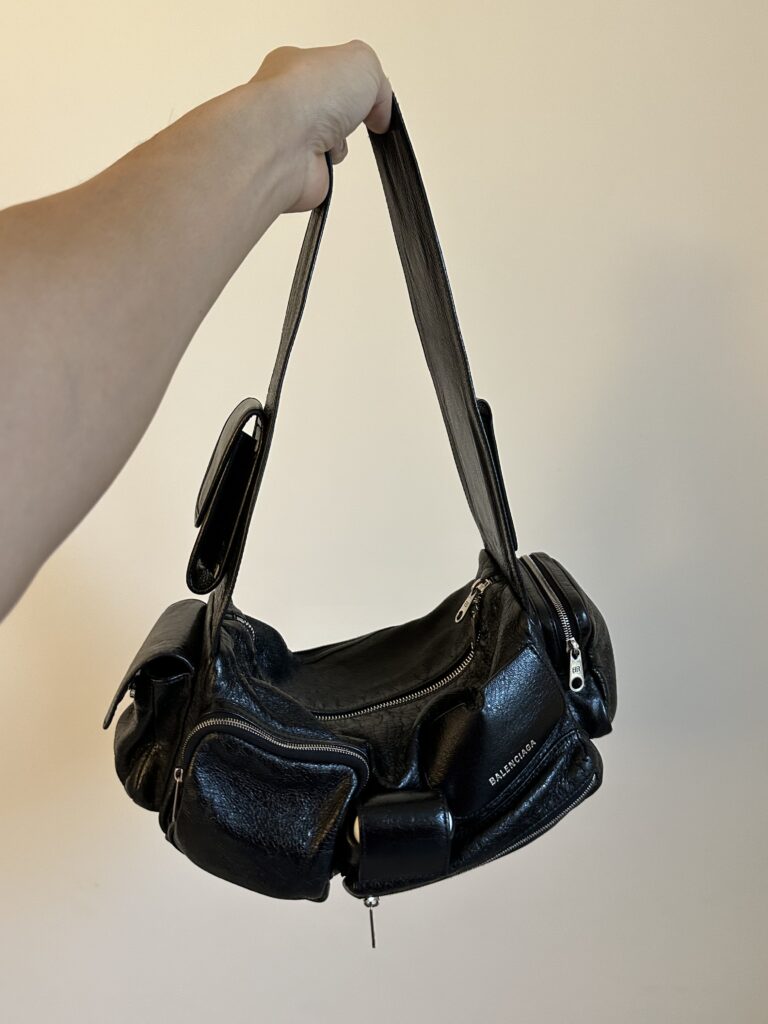
2. Balenciaga Superbusy Small Sling Bag
I see my friend Jeeu for drinks. She is also a bag person, so she knows that with every bag comes a story. I tell her I bought the last Musubi in Tokyo, and that it was for the memory. I was on vacation. It has been already very useful, I insist. There is wisdom, and pity, in her eyes.
When it is time to pay, she pulls a credit card out of a specially made holster on a shiny black leather bag I have never seen before. I tell her she really buried the lede. She hands it to me for inspection. It is a baroque version of a work bag, a shoulder bag covered in small pockets for keys, lip gloss, and credit cards but also for AirPods, a flip phone, and a ballpoint pen. It is cancerous with utility yet, in its excess of pockets and compartments, has nothing to do with the economical, only with the cute. In its orbit, I see a parody of my own life. Always so busy, so full of stuff. With what? the Superbusy seems to say. You are so silly, it says.
That night in bed I watch videos about bags. I find one video on the Superbusy, in a size bigger than the one I want, from a hardcore Balenciaga enthusiast with the username gallucks. Across the thirteen minutes and twenty-two seconds of “what’s in my BALENCIAGA bag ?,” gallucks zips and unzips its diverse assortment of pockets. “It’s basically got, like, a million pockets,” he says, holding it up to his face. “Which is probably why it’s the best bag ever to do a ‘what’s in my bag’ for.” He slings it over his shoulder and leans into its slouchy shape. He positions his arm in a V, contorting his body into a cute position. The bag’s zippers sound satisfyingly loud, portending heavy metal hardware.
I feel that the bag crystallizes the Balenciaga ethos of subculture, irony, and high fashion, and I want it. The Musubi, only a few months old, sits forlorn by my bed, its charm already dulled by acquisition. The iPhone looms over my face; it is the only light in the room. After I watch the video several times, I scroll through the rest of gallucks’s oeuvre to look for mentions of the bag and I find another vlog uploaded two years later, titled “nyc shopping with my boyfriend.” The bag appears again at 14:41 and 24:50. A few months later, I find the bag on a European resale website on sale for 20 percent off. I buy the Superbusy.
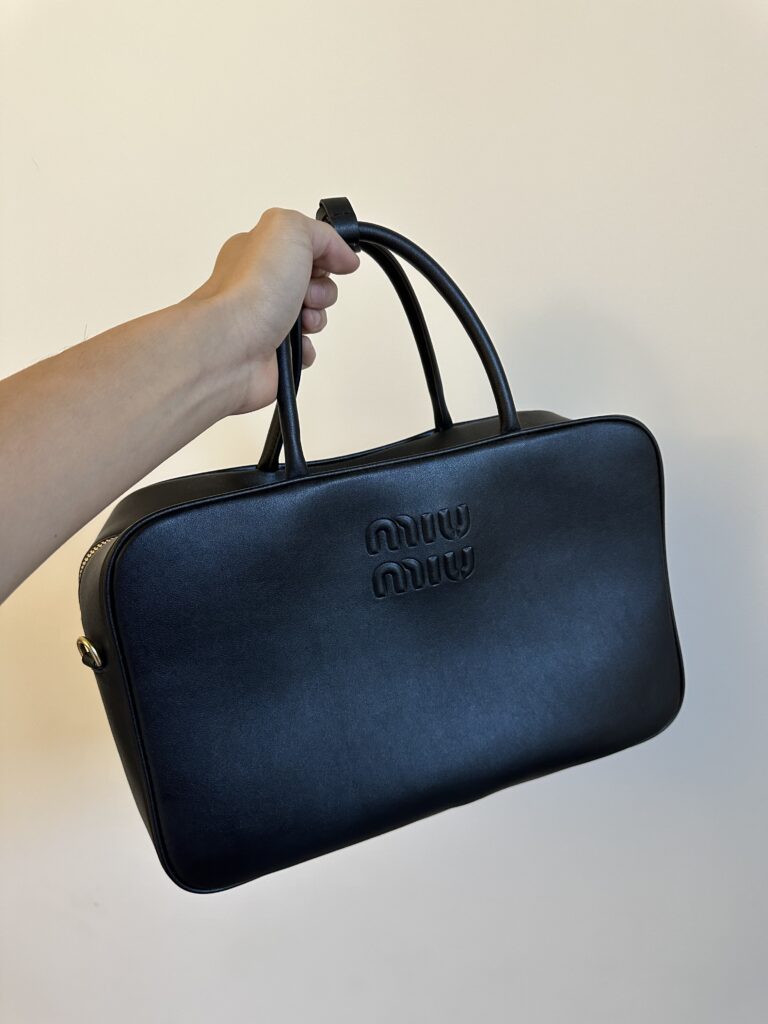
3. Miu Miu Leather Beau Bag (Yiguoluxe Version)
After much deliberation, my friend Alberto has also just purchased his first designer bag. It is a Miu Miu Leather Beau Bag. It is a thing of masculinity, made fey with soft leather and the brand’s logo embossed on the side. It has a simple handle long enough to sling over a shoulder but also short enough to carry in your hand. The bag’s boxiness can be complemented with colorful, childlike charms.
I want it too, I realize. But I can’t justify getting another bag so soon.
Online, I read about the rise of superfakes. The industry is largely sustained by Chinese housewives looking for supplemental income. They serve as salespeople for factories in China, liaising with individual overseas buyers over WhatsApp. They often know little about the bags’ production itself, in order to keep the supply chains safe from discovery. They manage entire empires from their phones.
Yet the gender and background of my salesperson is entirely up to my imagination. Their username is listed only as “Yiguoluxe.” All our business is conducted over WhatsApp. Their profile picture is of a handbag.
Through a link, I can see the newest wares from the Yiguoluxe factory. The hands that model the bags are slender, with finely painted nails, but they also seem to change with every bag. The list of available bags updates every few days. When I check the list a week later and cannot find where it ended last time for all the new additions, I feel dizzy.
It is the unintellectual thing to valorize the real over the fake, I tell myself. So I message Yiguoluxe. My messages consist of screenshots of bags that I am intrigued by, at first from runways and then, as I become more fluent in the ways of the superfake business, from the website that lists the company’s available wares. Yiguoluxe replies with prices. One time, I ask about a different bag and inexplicably receive a response in Spanish:
“Este producto esta temporalmente agotado.”
I imagine a woman sitting on an ornately carved wooden chair, her feet up on a table, French-tipped nails clacking away at her phone. I imagine a man in sweat shorts and an oversized T-shirt, typing to me through one of several desktops.
I look at the listing for the Miu Miu bag online ($3,850) and then at the one on Yiguoluxe ($139). I sigh and message that I would like to purchase it and ask what the next steps are. They tells me it will take nine to twelve business days for the bag to arrive from overseas. I am sent a PayPal link. While I wait, I become unsure about the bag’s quality.
“Is the bag close to original quality?” I message.
“Yes, they are all 1:1 high quality. We all make original molds and patterns at the counter.”
“They’re all made from first-layer cowhide,” they continue. Then they send a video.
In what looks like a small closet, hides of shiny black leather hang off a metal shelf. Behind the leather are other, folded hides, in blue and dark green. The floor is beige tile and the walls are off-white. As the camera moves, the hides glisten under the flat fluorescent light. Their edges are erratic but organic-looking, and I try to imagine what parts of the cow they may have originated from. A pale hand rubs a hide between its fingers.
The video neither reassures me about nor dissuades me from my purchase. I suspect Yiguoluxe sends it generically to many of their clients.
“Oh wow, great, thank you,” I write, and I follow up quickly. “What about the hardware?”
“Overall, it’s all good,” they write back.
“Ok this is my first time so I just curious,” I reply.
“It will definitely satisfy you.  ”
”
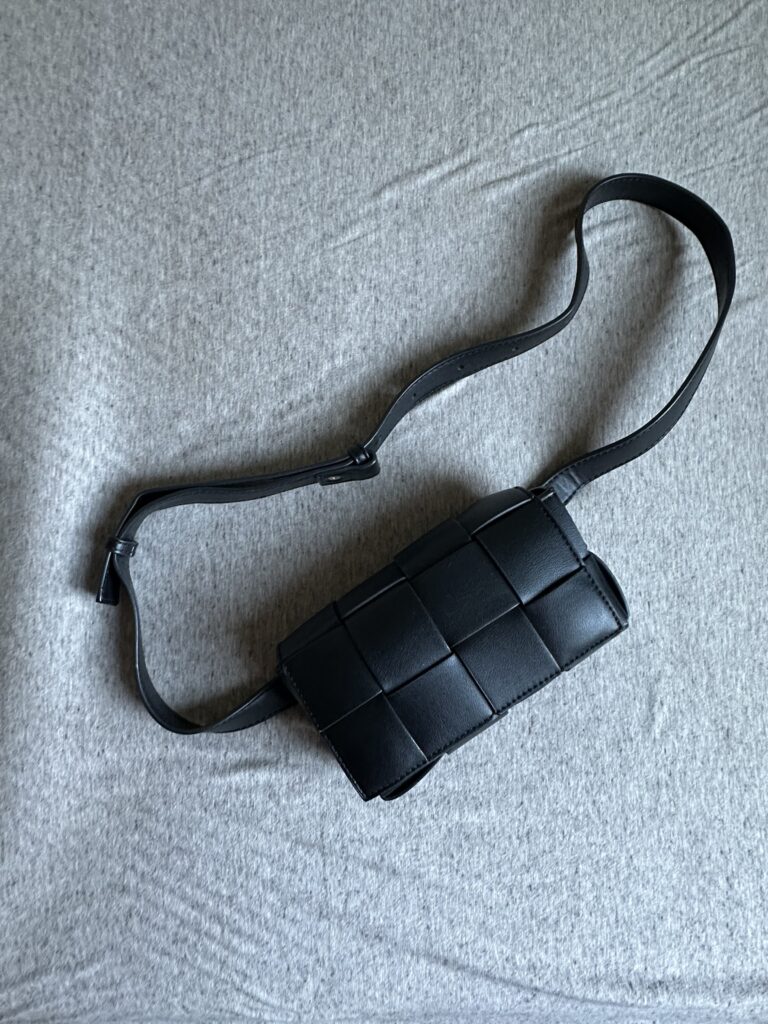
4. Bottega Veneta Cassette Mini Belt Bag (Yiguoluxe version)
Over the next year, I acclimate to the lives each of the bags requires of me. I find I reach for the Superbusy a lot, even though it cannot fit a book or a laptop. It is made of Arena lambskin, which is hardier than the Musubi’s calfskin. While the Musubi demands, by its material, to remain pristine, wear and tear add to the charm of the Superbusy’s subcultural mystique. They all make me inordinately happy—except the Miu Miu (Yiguoluxe version), which I still regard with suspicion. Having compared it to Alberto’s I know that it is almost indistinguishable from the real, but I still fixate on the way the zipper catches, or how the light seems to strike the leather in an unsatisfactory way. The real, it is said, speaks for itself, but the fake is always performing its authenticity. This anxiety sets it up to make mistakes.
I am embarrassed to carry it, and when I do, I wear it with the Miu Miu logo facing my body. Acne was my gateway into expensive brands, one that I could rationalize with its art-world adjacency. With a fake Miu Miu, I am squarely in the realm of class drag, of status symbol, the unjustifiable.
I return to the vloggers. Buying one, even three, bags did not sate my desire, I’ve found, but fracture it into a thousand new forms. I rewatch “what’s in my BALENCIAGA bag ?” and “nyc shopping with my boyfriend” like comforting reruns. I notice new videos have been uploaded and I compare the images of the bag with the one in my room.
I turn to the internet for reflection. “I cannot stop myself from buying handbags,” violeturq says in a January 26, 2016, post on Purseforum with the title “What causes an addiction to handbags?” She continues: “I’ve realized it’s a real addiction I have, but for the life of me, I cannot work out what’s behind it. I now have so many bags that I’m starting to fill up yet another wardrobe in yet another bedroom.” The members of Purseforum rush to commiserate with her. They share this inexplicable affliction. Their search for the “perfect bag” (which they acknowledge doesn’t exist) is detrimental, and understandable, but maybe she should also consider the possibility of a genetic predisposition towards addiction (“For my grandpa, it is alcohol. For my dad, he collects lot of junk -> sinks, pipes, tools, anything for home improvement. For me, I used to collect dvds/ movies, coupons, and now handbags/ slgs”). The replies go on for five pages, and lead to suggestions for scores of other blogs asking the same question. Some become very zen, reflecting on the unending nature of desire.
I close my laptop. Leaving my apartment to pick up takeout, I grab my keys and wallet and phone, and I look at my bags. Every one of them looks too big for the task. I now have a real big bag (Musubi), a real medium bag (Superbusy), and a fake medium bag (Miu Miu) but nothing small. I walk out holding my belongings in my hands, like a lunatic, and I mourn the lost opportunity to cherish something tiny.
Instagram algorithmically feeds me a small crossbody bag of interwoven leather strips from Bottega Veneta. As a brand, BV feels vaguely Mediterranean and vaguely aristocratic. I find its silhouettes generally too preppy for my liking. But this one is plain, rectangular, and black with a practical strap. TikTok algorithmically feeds me influencers who tell me that it will fit an iPhone 15, keys, a wallet, and even my headphones. It has no branding other than its design, and even my boyfriend, a normal person, approves.
The fashion TikTokers say that they do not regret paying $1,200 for it. I catch myself thinking, Oh, that’s not that bad, and I wonder who I have become. When I go to Boston to visit my boyfriend, I tell him I am going on a run, and I do go on a run, but I also stop by the Bottega Veneta store to try the bag on my body. In the store, I feel more winded than I do on my run, and when I put it on my body I feel a sense of wholeness. I also feel the smoothness of the leather; I slip my hand between the intrecciato weave to test its constitution. I fixate on the way the sales associate’s tongue trips gracefully when she says in-tre-cci-ato, as if it were a rare gem.
Back at the apartment, I open WhatsApp. A test drive, I say. A dress rehearsal, I say. You are so silly, the Superbusy says.
I order the Bottega Veneta Cassette from Yiguoluxe, for fifty dollars. When it arrives, I take it out of the box. I peer into its surface, trying to discern any outward manifestations of its fakery. The cowskin is dull, it is not supple as it was on the real. It has a rank, chemical smell. The woven leather strips feel loose when I pull them. The strap is stiff and retains a kink from its packaging that bothers me. My suspicions return.
The bag is still lacking something. I think: It is lacking trauma. I have experienced no financial pain in obtaining it, and I feel that I cannot recognize the bag’s love without the sting of sacrifice. Though I know the leather is real, I wonder: Did this bag come from a fake cow, in a fake pasture, with fake grass?
What is the exact texture of this fakeness, and what does it mean for my sense of reality? Online, I read an article about a man named Dominik Halás, who is master authenticator for the luxury vintage resale site the RealReal, and I decide to DM him, for research.
I meet Dominik at the Blue Bottle near the World Trade Center. He wears head-to-toe Yohji Yamamoto: a flowy black blazer; puffy Bermuda-length pants; and a blue shirt. He has a scruffy beard and blue eyes, and he is surprisingly young, just over thirty, if that.
He works at a five-hundred-thousand-square-foot warehouse in Perth Amboy, New Jersey, and he grew up in the New Jersey suburbs. He went to Brown, where he studied art history and architecture. He tells me he considers his primary life drive making his mother, an immigrant from Slovakia, proud. He says his role at the RealReal is his first full-time, salaried job. This job consists of assessing garments when they arrive, delegating the easier authentications to his team and picking out the most difficult garments for himself. He cross-references archival runway photographs, video, and occasionally manufacturing data, but much of his job is very subjective–it often involves smelling the garment, rubbing it between his fingers, assessing its textures.
I sip my tea.
I ask him what he thinks the purpose of the “real” is, and how it operates practically at his job.
“Well,” he says. “I think of it as preserving an artist’s legacy,” he says. “These are designers I admire, and I want them to have a legacy that is cohesive and true to what they intended,” he says. “It’s also a very subjective process that has me meld research with physical evidence.”
He offers to take me downtown to demonstrate. We walk to the designer vintage store Superette, where his girlfriend, an art history student at NYU, is working. He swipes through the racks quickly and identifies a red heavy-knit sweater and pulls it out.
“This,” he tells his girlfriend.
She gasps. “But …” She pauses. “You know who brought that in?”
We wait.
“Halsey. Why would Halsey bring in a fake?”
Dominik shrugs, and turns the red sweater inside out. He finds the manufacturer’s tag and rolls it between his index finger and thumb.
“Real LV will have a smooth feel when you do this,” he says. “But this one is rough, it catches,” he says.
I pull the tag, as he did. I peer into the knit of the red sweater, and I think of my BV bag. I look around me, at the store, at the garments, at Dominik and his girlfriend.
“You never know anymore,” the girlfriend says, and puts the sweater back on the rack.
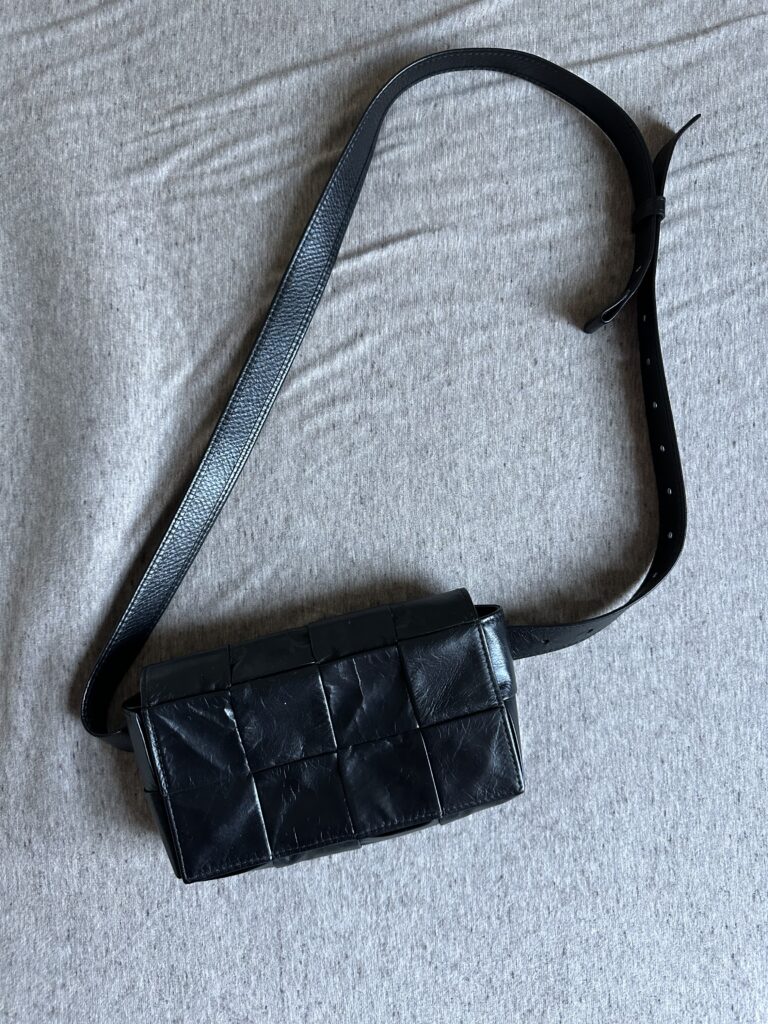
5. Bottega Veneta Cassette Mini Belt Bag
A year later, I buy a real one, used, for roughly $500, as a graduation gift for my boyfriend. We will share. I rub the papery leather between my fingers. I feel aristocratic, Italian, absurd, but at peace. I bring the cowskin up to my nose, to my own skin. My sense of reality is restored.
In The Carrier Bag Theory of Fiction, Ursula K. Le Guin writes: “If it is a human thing to do to put something you want, because it’s useful, edible, or beautiful, into a bag … then I am a human being after all.”
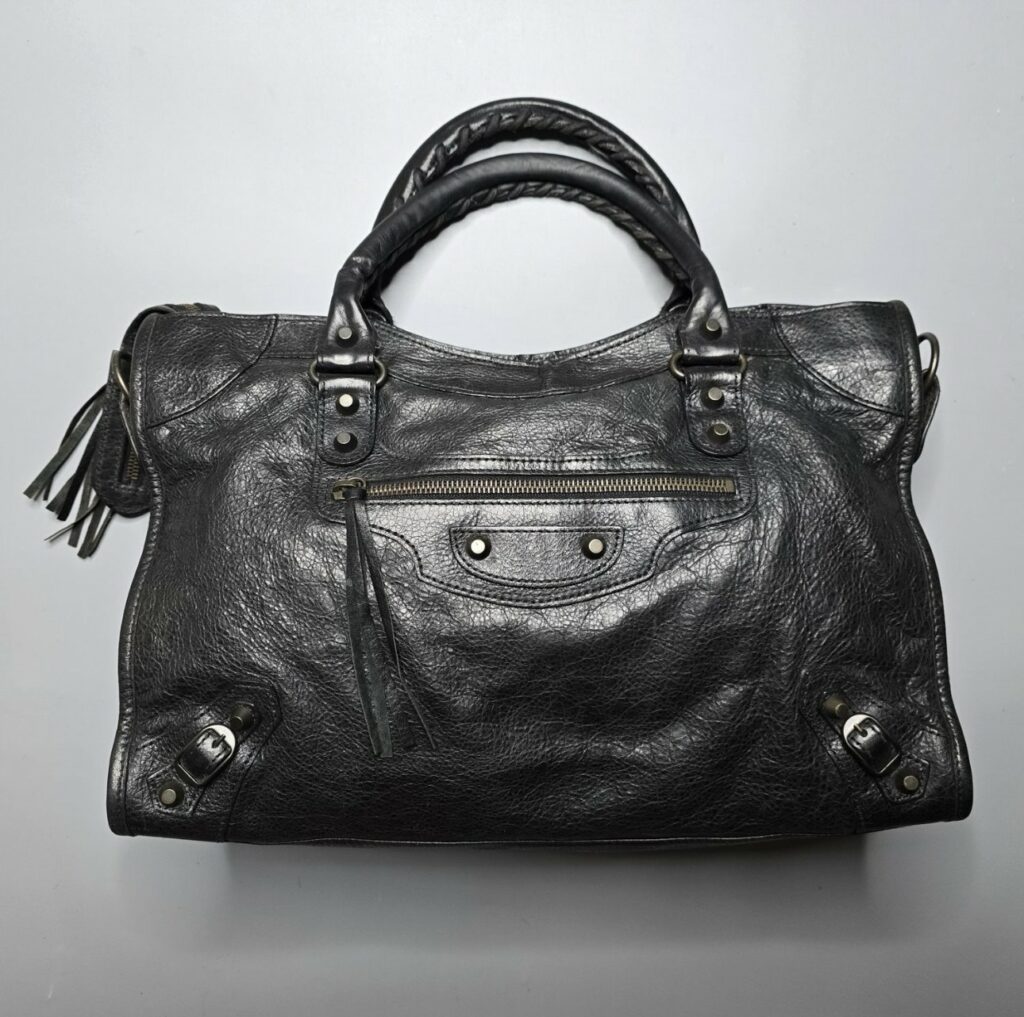
6. Balenciaga Le City Bag, circa 2011
I carry the Musubi for work, the Cassette for pleasure, and the Superbusy everywhere else. The fake bags sit in my closet. By touching each portal’s skin, I am elevated briefly to another plane, yet each touch also conjures the personal history of mania that led to its acquisition. Three years after my first purchase, I feel like a veteran of so many dopamine desire and fulfillment cycles. My desire for bags is earthly, human, and symbolic for all that can never be sated in my life. My desire might only be extinguished with years of Buddhist meditation practices, I think, practices that will gradually lead me to an Enlightenment free from bags.
Or I will admit that the chase is half the pleasure, and just buy used from eBay. I find a used Balenciaga Le City Bag for $350. My venture into archival design makes me feel like my collecting practice is (a) a practice and (b) developing depth and idiosyncrasy. Unlike the Balenciaga, the Miu Miu, or the Bottega, this bag has a design that remained popular from its release in 2001. When Balenciaga rereleases the bag a month later, I feel like I have beat a trend. I wonder if I might settle down.
The leather on this Balenciaga bag is slouchier even than the Superbusy’s, but the bag is more capacious. This portal is shaped like a rectangle. It has two top handles and burnished metal hardware. It sags dramatically when carried, the leather crinkled with age. It has two iron studs affixed to its front side that resemble eyes or alien bone. It fits a laptop and a water bottle, and I can return to the gym.
The leather is faded. There are stretch marks and patches that look like friction burns. I remember again that leather is skin. Using a moisturizer and gloves, I slowly massage the cream into the surface, moving in soft, upward circles, as I have learned from my own skincare regimen. I buff the cream with a small towel and then apply an additional layer of wax, kneading it into the cracks. When it is dry, I hang it in my closet for later use. Some days, I carry it with nothing inside at all.
Simon Wu is a writer and an artist. He is the author of the essay collection Dancing on My Own.

